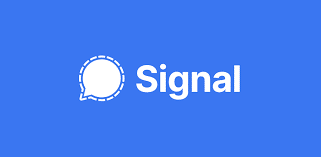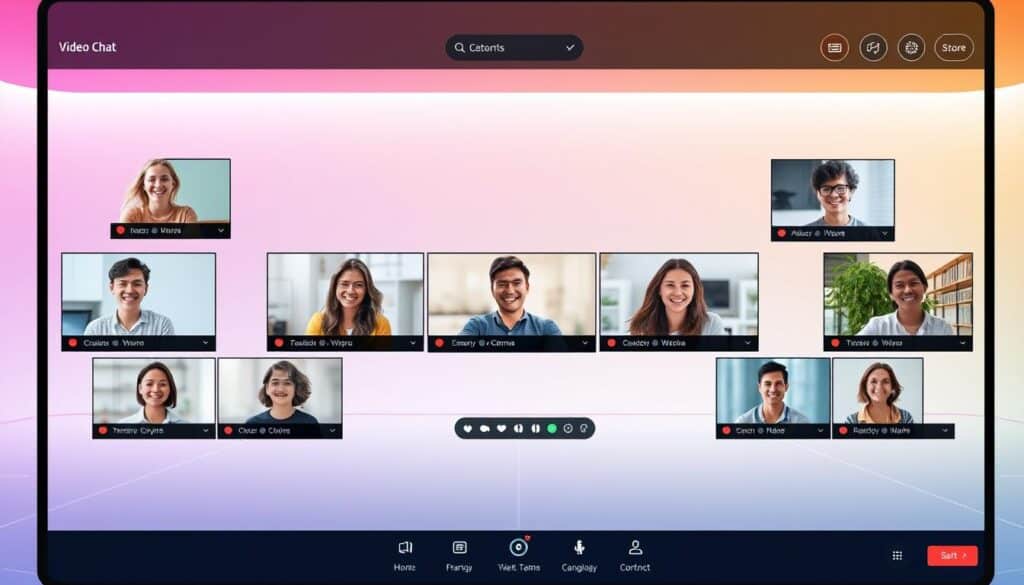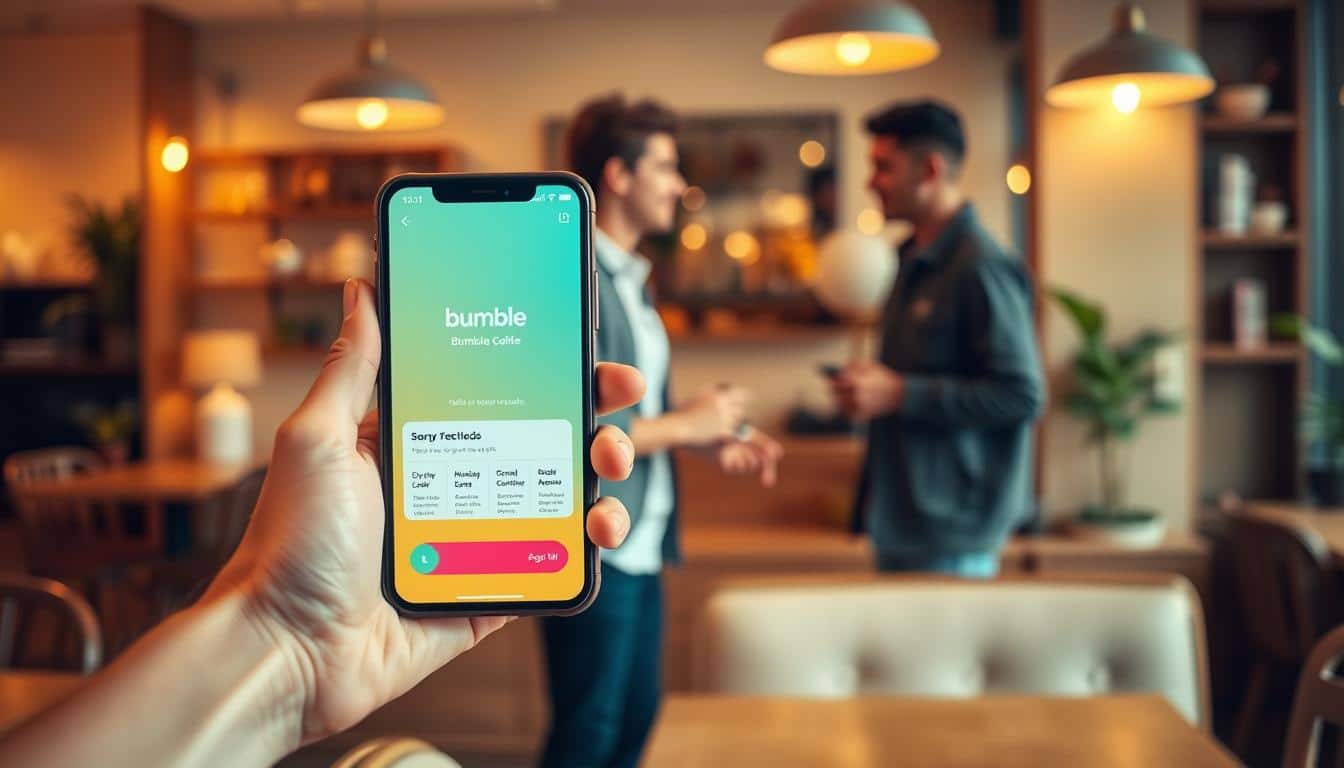Anúncios
Looking for the best chat platforms can save you time and cut down on stress. This guide helps people in the United States pick the perfect app. It’s great for staying in touch with family, friends, and even workmates.
Anyone hunting for the best chatting apps wants clear advice, smart comparisons, and tips for easy setup. We’ll discuss big names in messaging apps that people in the USA use a lot. This includes WhatsApp, Facebook Messenger, Telegram, Signal, Slack, Microsoft Teams, Discord, Zoom, Google Meet, and iMessage.
Anúncios

Our focus is on chatting online safely and easily. You’ll get a helpful guide looking at how easy it is to use these apps, how they protect your privacy, their main features, costs, and how to start using them. We’ll also talk about things specific to the U.S., like how iMessage works with SMS, if these apps work on your device, and how they fit your social and work life.
Key Takeaways
- Compare platforms by purpose: casual socializing, team collaboration, or privacy-first messaging.
- Major brands to know: WhatsApp, Facebook Messenger, Telegram, Signal, Slack, Teams, Discord, Zoom, Google Meet, and iMessage.
- Look for privacy, speed, and ease of use when choosing a messaging app.
- iMessage and SMS integration matter for many U.S. users on iPhone.
- Accessibility and device support should guide your final choice.
Overview of Chat Platforms and Why They Matter
Smartphones and fast mobile data changed messaging fast. Now, people prefer app-based messaging over voice calls and SMS. This overview explains how this change affected our daily lives, work, and communities in the USA.
Apps like WhatsApp and iMessage became part of our daily life over the last decade. While iMessage is popular among iPhone users, WhatsApp is used worldwide. For work, businesses often choose Slack and Microsoft Teams. These changes show how messaging trends in the USA impact our social and work habits.
How online chat has changed communication in the United States
Group chats help keep families together, even when they are in different time zones. Remote teams communicate more efficiently through channels and threads. And for hobbies, platforms like Discord create spaces for communities to grow.
Everyone wants their messages to sync quickly and reliably across all devices. This demand led developers to improve push notifications and make sure messages are received even when offline. Now, being quick and available is more important than ever in our messaging culture.

Signal
Key features users look for in chat apps: privacy, speed, ease of use
People value their privacy when messaging. Apps like Signal, WhatsApp, and iMessage offer end-to-end encryption, making many users feel secure. How apps handle metadata and data policies also influences trust.
Messages need to be fast and reliable. Users expect instant delivery and syncing across all their devices. Features that allow offline message writing are crucial in areas with poor signals.
How easy an app is to use plays a big role in its popularity. Users want simple setups and easy navigation. Facebook Messenger stands out for its convenience, while Telegram is preferred by those wanting a seamless experience across multiple devices.
Being able to use an app on different platforms with extra features adds to its appeal. Things like voice and video calls, file sharing, and bots make a chat app more useful.
How to choose the right platform for personal or professional use
Choose a platform that suits your needs. For privacy, go with Signal or Telegram. For work, Slack or Microsoft Teams are great choices.
Think about who you message the most. iMessage is great for iPhone users. A cross-platform app is better for groups with different devices.
Balance what’s important to you, like privacy, ease of use, and features. Casual users might prefer free versions, while businesses might need paid plans. Make a checklist to help compare options, looking at their audience, security, speed, and chat features.
| Use Case | Top Choices | Key Strength | Trade-Off |
|---|---|---|---|
| Private one-to-one chats | Signal, iMessage | Strong end-to-end encryption | Smaller feature sets for teams |
| Group social communities | Discord, Facebook Messenger | Community tools, voice channels | Complex moderation needs |
| Remote work and teams | Slack, Microsoft Teams | Integrations and file workflows | Cost for advanced features |
| Cross-device convenience | Telegram, WhatsApp Web | Multi-device sync and web clients | Different privacy models |
Best Platforms to Chat Online
Choosing chat tools is more than just brand names. People want tools that are easy to use, work on different devices, and protect their privacy. This part talks about options that focus on being easy to use and keeping users’ privacy safe. It also looks at how they work on different devices.
Why accessibility and user experience matter
Apps that are easy to use help people with different tech skills. Clear menus, easy-to-read fonts, and help for screen readers let more people start chatting quickly.
A good user experience keeps notifications up-to-date, syncs well between devices, and works well on older phones. These traits decide the best chat platforms for daily use.
Comparing cross-platform support and device compatibility
Chatting across platforms makes keeping up with friends easy on phones, tablets, computers, and browsers. WhatsApp is available on iOS, Android, Web, and desktop, focusing on mobile use. Facebook Messenger works on iOS, Android, and the web. Telegram is usable on iOS, Android, Windows, macOS, Linux, and the web, offering flexible syncing. Signal has apps for iOS, Android, and desktop, with top-notch privacy. Slack and Microsoft Teams offer strong desktop and mobile apps for teams. iMessage is for Apple users, with a simple way to text Android users. Discord is great for gamers and communities, working on desktop, mobile, and the browser.
iMessage works best for Apple users because it’s made for Apple’s products. Cross-platform apps can reach more people and fit better in all kinds of tech environments.
Considerations for privacy and data protection on popular services
Thinking about privacy helps you make better choices. Signal protects your chats end-to-end and doesn’t gather much data about you. iMessage and WhatsApp also protect most chats this way by default. Telegram only does this for secret chats, and stores others in the cloud. Facebook Messenger and Instagram messages, both part of Meta, collect more data for ads.
Always read privacy policies and turn on security settings like two-factor authentication. Using disappearing messages and checking app permissions can also protect your privacy.
| Platform | Devices | Encryption | Accessibility & UX Notes |
|---|---|---|---|
| iOS, Android, Web, Desktop | End-to-end by default (most chats) | Intuitive interface, strong mobile UX, limited desktop independence | |
| Facebook Messenger | iOS, Android, Web | Optional Secret Conversations (E2EE) | Feature-rich, integrated with Meta services, heavier data use |
| Telegram | iOS, Android, Windows, macOS, Linux, Web | Secret chats E2EE; cloud chats not E2EE | Fast syncing, many platforms, customizable but mixed privacy model |
| Signal | iOS, Android, Desktop | End-to-end by default | Privacy-first, minimal metadata, straightforward design |
| iMessage | iOS, macOS, iPadOS (SMS fallback) | End-to-end for Apple-to-Apple | Seamless Apple integration, limited cross-platform reach |
| Slack | iOS, Android, Windows, macOS, Linux, Web | No default E2EE for all chats | Built for teams, strong desktop apps, many integrations |
| Microsoft Teams | iOS, Android, Windows, macOS, Web | Enterprise controls; not full E2EE by default | Robust collaboration tools and cross-platform support |
| Discord | iOS, Android, Windows, macOS, Web | No default E2EE | Great for communities, rich media and voice, browser-friendly |
Top Platforms for Casual Conversations and Socializing
Staying in touch with friends should be easy and enjoyable. Casual chat apps and social messaging platforms make it simple to check in, share photos, and organize group events. We’re going to look at popular choices and explain how they bring people together. We’ll also give tips on keeping your chats safe and kind.

Apps that make staying in touch effortless
Facebook Messenger connects you with many users. It allows free voice and video calls. WhatsApp lets you chat privately with end-to-end encryption, using your phone number. iMessage works great for Apple users, with SMS options and fun features like Memoji. Snapchat offers messages that disappear and AR lenses, which are a hit with the young crowd.
Community features, groups, and interest-based chats
Discord is great for organizing chats into channels. It has voice rooms perfect for gamers and hobbyists. Telegram offers large public channels, bots, and supergroups for big communities. Facebook Groups combines with Messenger. It helps link social profiles with local or hobby-centered groups.
Best practices for moderation and safe social interaction
- Make rules for behavior clear and post them where newcomers can easily find them.
- Have trusted moderators on hand to enforce rules and manage troublemakers.
- Ask for verification in communities where trust is critical to decrease the risk of fake profiles.
- Encourage keeping private talks to direct messages and avoid sharing personal info in public.
- Report any abusive users to the platform’s support team and document any incidents.
For group creators and managers, combining easy-to-use chat apps with smart moderation practices helps create a safer environment. Choose platforms that your audience loves. Use moderation tools to keep the vibe friendly and welcoming.
Best Chat Platforms for Professional and Team Communication
Choosing the right chat platform is crucial for team work. The top apps offer clear communication channels, speedy searches, and helpful integrations. These keep tasks moving smoothly. Teams consider speed, integration options, and security before selecting an app.
Tools optimized for collaboration and productivity
Slack is known for its organized channels, easy-to-find history, and many app connections. It works with tools like Jira, Google Drive, and Zoom. Microsoft Teams integrates closely with Microsoft 365, enhancing collaboration through Outlook and SharePoint. Google Chat works well with Gmail and Drive, supporting team flow.
Integration with calendar, file sharing, and project management
Integration with calendars is key for planning. Outlook pairs with Teams, and Slack users can link Google Calendar. File sharing is fluid with OneDrive and Google Drive. Also, documents can be edited right inside these platforms. Task management tools like Asana and Trello turn chats into action items.
Security and compliance features for business use
Security is a top concern for businesses. They look for features like single sign-on and data protection. Slack and Teams both offer advanced security options. Meeting compliance standards like SOC 2 is also important. For handling health data, firms might need HIPAA support, available with Microsoft or Google.
For extra security, use two-factor authentication and set device rules. Adjust data retention to meet legal requirements. Doing regular checks and limiting access maintains strong security in chat apps.
Choosing between Slack and Teams often depends on company needs. Slack is great for its wide range of integrations. Teams is preferred for those needing close Microsoft Office connections. Many companies try both to find the best fit for their workflow and rules.
Messaging Apps Focused on Privacy and Security
Conversations about work, family, or personal things need privacy. Many people now pick secure messaging apps to protect their chats from advertisers and cyber threats. This part talks about end-to-end encryption, compares privacy-focused apps with popular ones, and gives tips for keeping accounts and talks safe.
End-to-end encryption: what it means and why it matters
End-to-end encryption means only you and the person you’re talking to can read what’s sent. No one else, not even the app’s makers, can read your messages. This keeps your messages, calls, and files safe from being intercepted while they travel.
Signal uses its own encryption method for messages and calls, which makes it very private. WhatsApp and Signal use similar methods for chats and calls. Apple’s iMessage also encrypts messages between Apple devices. But, some info might still be recorded by these services.
Privacy-first apps versus mainstream alternatives
Signal stands out because it keeps very little info and its code can be checked by anyone. Telegram lets you have secret chats that are encrypted end-to-end, but its regular chats are not as private. This means fast and convenient features might come with less privacy.
Wickr and Threema focus on security for business users and those who value privacy. They offer special features, but they cost money. WhatsApp, owned by Meta, encrypts messages well but collects more info about you. Choosing between Signal and Telegram shows a big decision: total privacy or more features with some privacy.
Tips for protecting your conversations and accounts
Turn on two-factor authentication for apps like Signal, WhatsApp, and Telegram. This extra step keeps your account safe, even if someone knows your password.
To keep sensitive info safe, use messages that disappear and don’t back up chats without encryption when privacy is key. Some apps, like WhatsApp, ask you to turn on backup encryption yourself.
Always update your apps to fix security bugs and check in-app safety numbers or fingerprints when you can. Protect your device with strong passwords, fingerprint locks, and encryption.
Platforms for Video and Voice Chat Integration
Finding the perfect video and voice tools can totally change how we work and connect. Some of us need to see faces clearly and choose video-first tools. Others like starting with text and only use calls when necessary.

When to pick video-first versus text-first
Zoom, Google Meet, and Microsoft Teams are great for lessons and big meetings. They’re perfect when you need to see faces or share your screen. They’re top choices for any planned event.
Slack, Discord, and Telegram are awesome for teams who chat all day and want quick replies. With these, you can easily start a voice call or video chat without losing your chat history.
Latency, call quality, and group call limits
How good your call looks and sounds depends on the tech behind it and your own internet. Zoom adjusts to keep calls smooth, even on iffy connections. Microsoft Teams and Google Meet are also smart about this.
Every service has a max number of people for group calls. Zoom has a limit, especially for free users. Google Meet does too, but it can change. Discord lets lots of people join, which gamers and friends love.
Picking the right platform means thinking about breakout rooms, recording, live streams, and how many people can join. These features are key for lessons, big meetings, and workshops.
Useful hardware and network tips for better calls
For the best call quality, use a wired connection or 5 GHz Wi-Fi. Use a headset with a mic to reduce echo and make clear calls. Always test your mic and camera before any important call.
Shut down apps you’re not using to free up the internet, and use noise canceling options in Zoom, Teams, or Discord. For those leading the call, external webcams and mics are much better than what’s already in your laptop.
Here’s a quick guide to help you choose the right tools based on what you need.
| Use Case | Strong Choices | Key Strengths |
|---|---|---|
| Webinars & large meetings | Zoom, Google Meet | Breakout rooms, robust host controls, recording, best video calling apps for formal events |
| Team collaboration | Microsoft Teams, Slack | Calendar and file integration, threaded text chat, in-app calls |
| Casual voice communities | Discord | Persistent voice channels, high participant capacity, low restrictions on session length |
| Privacy-focused calls | Signal (voice/video), Telegram (voice chats) | End-to-end options, lightweight voice chat apps for private conversations |
| Choose between Zoom vs Google Meet | Zoom, Google Meet | Zoom offers extensive host features and webinar tools; Google Meet ties closely to Google Workspace and is simple for quick meetings |
Chat Platforms with Rich Media and Platform Features
People now chat differently online, thanks to rich media messaging. Photos, GIFs, and reactions make conversations come to life. Facebook Messenger, Telegram, WhatsApp, iMessage, and Discord offer smooth sharing. They keep talking fun with cool features.
Sharing photos, GIFs, reactions, and custom stickers
Users can send images, live videos, and GIFs right in chats. iMessage and WhatsApp make sharing easy. Telegram is great for big files and clear media. Snapchat’s focus is on media that vanishes, allowing for fun, private talks.
Chat stickers and emoji reactions add flair to messages. GIF apps like GIPHY integrate with many platforms. This means users can find and share animations without leaving their chat. It helps make ideas clearer and quicker to share.
Bots, automation, and advanced chat features
Chat bots add new abilities to platforms. For example, Slack bots can send updates and streamlines work. Telegram bots manage polls and can post stuff by themselves. Discord bots are handy for keeping things orderly, playing music, and assigning roles. These bots save teams from repetitive tasks and make them more efficient.
Tools like Zapier and IFTTT connect chats with calendars, CRMs, and storage. Features like conversation threads, channel roles, and highlight messages organize group chats better. Searching messages and scheduling them keeps everything important noticeable and timely.
How rich media improves engagement and user retention
Visuals catch the eye quicker than long texts. Rich media gets more users to engage because they respond faster to visuals and clips. Teams work faster solving issues with screenshots and notes. Social chats become more engaging when stickers and GIFs convey feelings quickly.
Platforms offering easy sharing of media and good integrations see more daily use. Expressive content and task automation encourage users to stay longer and come back more often.
How to Set Up and Get Started on Popular Chat Platforms
Getting started on chat apps is easy if you follow some steps. First, download the app from either the App Store or Google Play. Then, choose how to sign up – you can use a phone number, an email, or an account from Google or Microsoft. We’ll show you how to set up your account, adjust privacy settings, and add contacts so you’re ready to chat.
Account creation, verification, and profile optimization
First, open the app and hit Sign Up. With apps like WhatsApp, Telegram, and Signal, you’ll use your phone number. Google Meet or Microsoft Teams need a Google or Microsoft account. Pick a clear name and a photo that friends can easily recognize.
Verify yourself with an SMS or email link. Connect an email to get back into your account if your device is lost. Putting a bio or status lets others know a bit about you without sharing too much.
Privacy settings and permission management walkthrough
Let the app use your camera and mic for calls. Turn on notifications to not miss anything important. Only give access to your contacts if you want to find friends in the app. You can always change these permissions later in your phone’s settings.
In apps like WhatsApp and Facebook Messenger, you can hide when you last checked the app. Block people you don’t want messages from. Set messages to disappear for private talks. Always back up your chats, and encrypt them for security.
Tips for importing contacts and joining groups or channels
Most apps will ask to look at your phonebook to find friends. Say yes to match numbers with accounts easily. On your computer, you can add people by syncing your email or address book.
Use invite links to join groups on Telegram and Discord. Always check who’s running the group and the rules. This keeps you away from spam and fake news.
Below is a guide to help you figure out the basic settings for different apps.
| Platform | Create Chat Account | Common Permissions | Contact Import Method | Key Privacy Option |
|---|---|---|---|---|
| Phone number signup and SMS verification | Contacts, microphone, camera, storage | Grant phonebook access for automatic import | End-to-end encryption and disappearing messages | |
| Telegram | Phone number or username creation | Contacts, microphone, camera, notifications | Invite links, phonebook sync, email invites on desktop | Public channel controls and two-step verification |
| Signal | Phone number signup with SMS verification | Contacts, microphone, camera | Phonebook access for secure import | Strong privacy defaults and disappearing messages |
| Microsoft Teams | Microsoft account or work email | Camera, microphone, calendar, contacts | Directory sync and email invites for team members | Admin-managed permissions and compliance controls |
| Google Meet | Google account sign-in | Camera, microphone, calendar integration | Import contacts from Google Contacts | Meeting codes and host controls for entry |
Cost, Plans, and Value: Free vs Paid Chat Services
Choosing the right chat service is about balancing features and cost. People often start with free apps like WhatsApp and Telegram. Then, small teams might try free versions before paying for Slack or Zoom. Knowing about chat app prices helps choose the best one for you or your company.
Comparing free tiers and premium subscriptions
Free plans offer basic texting and calls for small groups. They usually have limits on things like how many messages you can keep. Paying more removes these limits and adds better tools. For instance, Slack’s higher plans offer more than just unlimited messages.
Which features are typically behind paywalls
Paying more usually gives access to bigger groups and longer meetings. Advanced security and support are also behind paywalls. For businesses needing top-level security, pricier plans are a must.
How to evaluate value for personal and business needs
Think about whether premium features are worth it for personal use. Most people find free services enough. Businesses, however, should weigh costs against how much more work gets done. Checking how a chat app works with other tools you use is also smart.
For U.S. users, small teams might pay a small fee per person each month. Bigger companies pay per user plus extra for management features. Trying these features during free trials helps decide if they’re worth it.
Make a list of what to test during trials, like meeting records or security needs. This helps understand what you’re really getting, making sure you choose what works best for your goals.
User Experience and Accessibility Considerations
A great design keeps chat simple for all. It avoids clutter and has straightforward onboarding to reduce starting time. Walkthroughs in Slack and light onboarding in Telegram show the way. They make it easy for people to learn and use the app quickly.
Navigation should be easy to understand. It’s key to use clear channel names, consistent icons, and tooltips that help. Having template messages and quick reactions makes team communication smoother. Messenger’s seamless link with Facebook shows how to make it easier for existing users.
Accessibility in messaging apps must have captions, screen reader compatibility, and adjustable fonts. Google Meet and Microsoft Teams give live captions during calls. Zoom offers live transcribing for paid users or through special integrations. Many follow ARIA rules and share keyboard shortcuts helpfully.
Apps that use iOS and Android’s own accessibility settings usually perform better. This helps those needing bigger fonts or high-contrast screens. iMessage, WhatsApp, and Slack adjust to system font sizes well. Some even let users tweak themes and text sizes within the app for better viewing.
Performance is key when internet is slow or devices are old. Apps like Telegram and Messenger Lite use less data and load faster. Features like low-data modes and limiting media download are useful. They keep chat running smoothly no matter what.
Making chat work with low bandwidth includes server tricks. These are things like adjusting streaming quality and shrinking message size. Choosing audio calls over video and smaller images saves battery and data money.
Design, accessibility, and performance are essential. They ensure messaging apps offer a good user experience. Focus on helpful tooltips, clear processes, and accessibility tests. This ensures everyone can take part in the chat without trouble.
Conclusion
This guide to messaging apps in the USA sums up how to pick the best chat platforms. Choose Signal for private talks, WhatsApp or Facebook Messenger for reaching many people, and Microsoft Teams or Slack for working with colleagues. Discord and Telegram are great for creating communities. Every app offers a mix of ease, features, privacy, and cost.
It’s important to know the trade-offs before deciding. Apps that work across different devices and have lots of features are handy. But, they may not be the best for privacy or could have fees. For private conversations, go with an app that uses encryption. Teams and Slack are best for workplace use because they have tools for managing your team.
To start, figure out who you mainly talk to—whether they’re family, friends, or coworkers. Then, try out one or two apps to find the best match. Always use two-factor authentication, check your privacy settings, and update your apps to keep your chats safe. Try making a small group or a trial project to really see how the app works. Change your approach based on what you learn from using the app.



